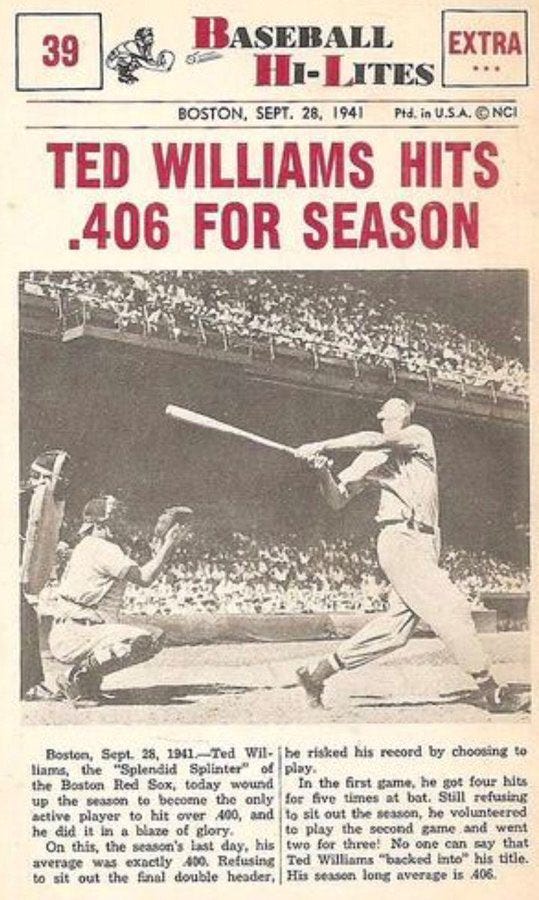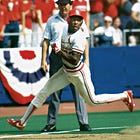The Endorsement: Batting Average (1985)
As baseball's analytics era becomes institutionalized, a simple number still matters.
This is Throwbacks, a newsletter by me, Michael Weinreb, about sports, history, culture and politics, and everything in-between.
If you like what you read, please click the button below, join the mailing list for FREE and please share, on social media or through e-mail or however you feel comfortable sharing.
And if you’ve been reading for a while, please consider a paid subscription to unlock certain posts and help keep this thing going—you’ll also get full access to the historical archive of over 250 articles. (Click here and you’ll get 20 percent off either a monthly or annual subscription for the first year.)
(If your subscription is up for renewal, just shoot me an email and I’ll figure out a way to get you that discount, as well. If you cannot afford a paid subscription and would like one, send me an email and I’ll comp you one, no questions asked.)
I.
Forty years ago this summer, a soft-spoken St. Louis Cardinals center fielder named Willie McGee found himself in the midst of an extraordinary season. In his first three years in the major leagues, McGee had put up batting averages of .296, .286 and .291, which were respectable enough to earn him a spot in an All-Star game (he also stole over a hundred bases total during those three seasons, and won a Gold Glove). Over the course of an 18-year career, McGee would hit .295 and make four All-Star teams; he was, in the end, an excellent ballplayer who will probably never earn serious Hall of Fame consideration. But in that one season—in the summer of 1985—something kind of crazy happened: Willie McGee hit a league-leading .353 and was named baseball’s Most Valuable Player as the go-go Cardinals came one game away from winning the World Series.
I had to look up many of the numbers in the above paragraph, but one I did not have to look up was McGee’s .353 average. Here is something I have learned over the course of two years of regularly playing the Immaculate Grid: When you are a child of a certain age, and if baseball works its way into your bloodstream—if you find yourself poring over the backs of baseball cards and memorizing Statis-Pro Baseball ranges—there are numbers that linger. And for me, McGee’s .353 average is one of those numbers.
I am not and have never been a St. Louis Cardinals fan, and I have no idea why or how this has inadvertently become a newsletter about the 1985 Cardinals (though perhaps it is a subliminal effort by Cardinal superfan Will Leitch to promote his new novel). Yet for some reason, Willie McGee’s batting average in 1985 is one of those things that is permanently glued to the walls of my hippocampus, and I think it is because, for so long, batting average was one of the most romantic numbers in baseball. Batting average was something that helped me to fall in love with baseball in the first place. And it is odd to me now that this number means nothing at all.
II.
I will admit that I was not familiar with the resume of a baseball player named Luis Arraez until a few weeks ago, when I attended a game between the San Francisco Giants and San Diego Padres. There are a lot of numbers that seem engineered to glaze the eyes on your average stadium Jumbotron these days—it’s an almost deliberately obtuse jumble of readouts, like a Star Trek control panel. But there was one number that stood out to me: Over the course of the entire season (as I write this), Arraez has struck out a total of five times. Even the good hitters strike out in prolific numbers now; it is not uncommon for an All-Star caliber player to strike out five times in one game. And that is how I realized that I had completely missed the entire Luis Arraez narrative.
Now, if you are a hardcore baseball fan who follows the full scope of the league (unlike many of us who watch baseball with a narrow scope these days), you are probably aware that Arraez has won three straight batting titles, and you are probably thinking that I am an idiot for not knowing this. I cannot blame you for that. I feel a little bit embarrassed about it myself. But it is also true that Arraez has won those three consecutive batting titles while also playing for three different teams. In 2023, he was traded from the Twins to the Miami Marlins for a pitcher named Pablo Lopez and a couple other prospects; a year later, he was traded to the Padres for four more prospects.
Luis Arraez is incredibly good at doing the one thing that centrally defined baseball for its entire existence: He can hit ‘em where they ain’t, even if he doesn’t hit ‘em particularly hard. But in the modern analytics era, this does not make him a valuable commodity. In fact, as The Athletic’s Dennis Lim wrote last year, it makes Luis Arraez arguably the most polarizing player in the sport. The best pure hitter in baseball—at least in terms of being able to place a bat on a ball—is essentially a disposable journeyman.
III.
I don’t mean this to be yet another condemnation of baseball’s analytics era, but it does make me wonder if maybe the people who are most immersed in the sport from day to day no longer have the perspective to realize what they’ve sacrificed along the way. As baseball has immersed itself in the complexities of its new math and science, it’s not only become more obtuse and more intimidating—it’s also begun to value different things that might have a more direct impact on winning and losing. It’s become hard to follow; it speaks an entirely new language. If you don’t acknowledge that Luis Arraez simply isn’t a valuable commodity anymore, you’re dismissed as a Luddite. And I know I am not the first person to say this, but I really do think that’s part of the reason why baseball doesn’t have the broad cultural relevance that it once did, and might not get it back anytime soon.
Keep reading with a 7-day free trial
Subscribe to Throwbacks: A Newsletter About Sports History and Culture to keep reading this post and get 7 days of free access to the full post archives.






